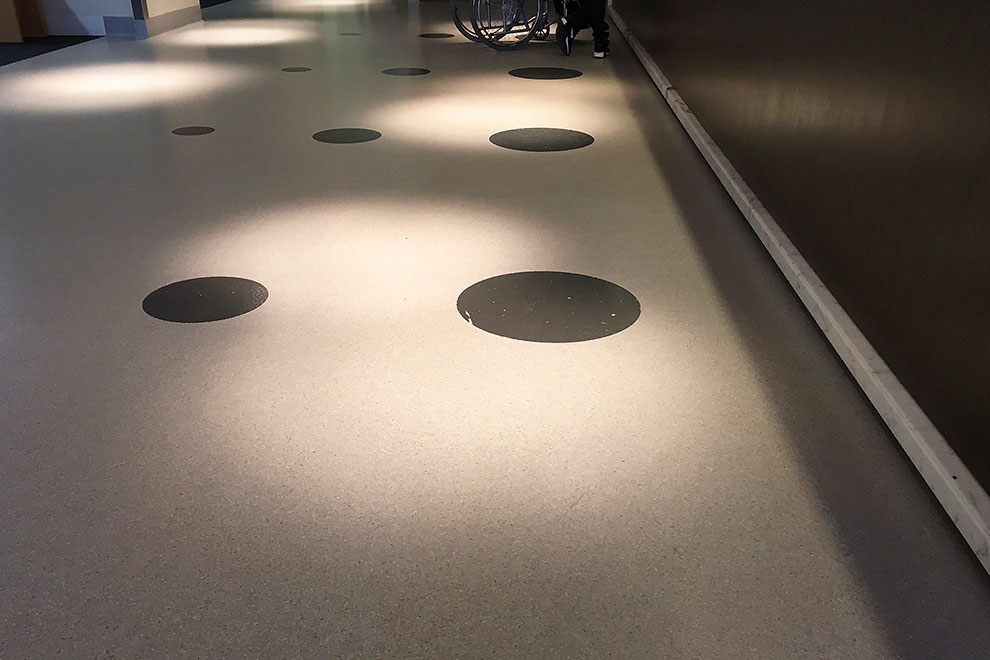30 June 2016: The line at the reception desk at the Alfred Hospital’s liver clinic is long. The other counters in the outpatients area are empty; every so often a staff member calls out, “Orthopaedics? Orthopaedics?” and occasionally somebody on a stick or with a bad limp hobbles over to one of the other three reception booths. But this makes little difference to the number of people waiting for “the cure,” which has been made possible by a new class of drugs known as direct-acting anti-viral medicines, or DAAs.
An estimated 225,000 people are living with chronic Hepatitis C infection in Australia. Of these, according to the Kirby Institute, more than 26,000 received the new treatment within six months of its listing on the Pharmaceutical Benefits Scheme in May this year.
The people waiting in line are a diverse group: the down-at-heel, the suburban, the inner-urban, and me – an artist, university lecturer and mother. I speculate that, like me, most of them wonder at some point how the others in line got infected – blood transfusion, needle stick, tattoo, surgery, drug use? In the early 1970s, I was a curious teenager with a deep underlying unhappiness. Underwhelmed by the world and my peer group, I blotted out my disappointment and boredom by experimenting with drugs.
Fast forward to 1994. A few weeks before my fortieth birthday, I took a Hep C test. The virus had only been identified a few years earlier. I was suffering from regular fatigue and my doctor and I expected this to be a routine, just-in-case test, part of a process of ruling out possible causes of my overwhelming tiredness. “It looks like you’re clear but your liver function is slightly out,” said my doctor, glancing at my results. As she read further, she recanted. “It says ‘virus detected,’” she told me, then picked up the phone and rang the lab to check there wasn’t a mistake. “I’m so sorry,” she said, as I descended from the realm of the healthy into the world of the chronically ill, stamped with a life-threatening disease.
At that stage, the experts said Hep C wasn’t a death sentence, though the limited statistics suggested that one-in-four people with the virus would progress to cirrhosis and liver cancer. I was fortunate that my family, friends and co-workers treated me well, but I felt alone and uncertain about what the future would hold. This was an era of new and frightening diseases. HIV/AIDS had been identified in 1983; Hep C in 1989. People were scared because, suddenly, blood was dangerous.
It’s no surprise that a lot of misinformation, and fear and discrimination, was swirling around. Information about the disease was scant, and I was terrified. So I rang the Hep C Helpline. In a tiny office at Fairfield Infectious Diseases Hospital, where the casualties of the AIDS epidemic were hospitalised, a small group of volunteers shared the phone roster. There were no staff members paid to provide accurate information about the virus, just this generous but untrained crew of helpers offering support.
As part of my own self-education and psychological cure, I too began volunteering on the phones. I started the Good Liver newsletter and secured funding from a philanthropic trust, the Myer Foundation, to employ a part-time worker. I buried myself in the business of supporting others and was eventually successful in dragooning a reluctant state government into funding the organisation now known as Hepatitis Victoria.
For those of us who were diagnosed during this time, however, the only potential “cure” was interferon, which had low and inexact success rates and was accompanied by the certainty of devastating side effects – flu-like symptoms for up to a year or worse, and a psychological toll known as psycho-toxaemia. My liver was still reasonably healthy, so that path wasn’t for me. Nor were the unreliable outcomes of subsequent combination therapies enough to lure me into the realm of the ghastly side effects of drugs that were only partially successful in treating the virus.
When news of the Hep C cure arrived, hope was tempered by anxiety about the cost. Initially, the federal government appeared reluctant to subsidise expensive DAAs. When the decision to list the new treatment on the PBS was announced on 1 March 2016, I immediately presented myself to my GP, but the path to a prescription proved convoluted. At that first consultation, my doctor was unable to proceed because the health department had not yet authorised GPs to prescribe the treatment. Once instructions were issued, prescriptions required authority from Canberra and supervision by a liver specialist. I had to repeat a battery of tests to confirm the specific genotype of my virus and the condition of my liver.
On this day in June 2016, though, after decades of living with Hep C, I am standing in line waiting for my first dose of pills under the new treatment regime.
28 July 2016: Last night I swallowed the last tablet in the bottle. So I know it’s four weeks since I commenced treatment and time to get the result of my first blood test. As I wait to see the specialist, I am relieved that nobody will ask me how I contracted the virus. For years, when I visited doctors, I had to advise them that I carried the Hep C virus. Sometimes, if I was having a blood sample taken, I would have to remind the nurse to put on gloves.
In some cases, medical professionals crossed the line and asked how I got the disease. My answer depended on the context and my own level of vulnerability at the time. After all, I can’t be sure how and where I was infected. I may have contracted the virus during my experimentation with drugs, or I may have been exposed to the virus in 1985, when I was admitted to a Thai hospital with Dengue fever and subjected to numerous blood tests with non-disposable needles. The latter version of the story would invariably elicit the response, “Oh, you poor thing.” The unhappy youth narrative was generally met with silence, an unsympathetic look and an uncomfortable wriggle in the seat. “But,” I always wanted to say, “it’s all about blood and we didn’t know how dangerous it was in those days.”
At this second appointment at the liver clinic, specialist Peter Jennings boots the computer into action. After a bit of chat and some cursing at the antiquated system, he says, “Have a look at this.” There, clearly on the page, are the words “virus not detected.” I can’t believe that after twenty-odd years of wondering if and when this virus was going to fatally attack my liver, its time in my life is drawing to a close. I still have two more months of treatment to go, but I feel relieved that in future I will no longer need to “fess up” to the consequences of a misspent youth every time I fill in a medical record, nor panic every time I shed a drop of blood. (I will continue to observe the same procedures, though, because these days, as we all know, blood can be dangerous.)
What is true for me is true for tens of thousands of others. Over the decade to 2015, the number of people with cirrhosis of the liver doubled as Hep C took its toll on an ageing population. Health minister Sussan Ley has made the cure available to all people infected with the virus, regardless of the state of their liver – patients don’t have to wait for cirrhosis to set in. This public health approach makes Australia a world leader in tackling Hep C.
The cost of listing the drugs on the PBS and making them available to anyone with Hep C will be high – more than $1 billion – but the government hopes the new treatment “could all but eradicate the deadly and debilitating disease within a generation.” It will not only save lives, it will transform them; this is a one-off hit to clear the virus rather than condemning sufferers to a lifetime of medical treatment and disease management. In the long term, it should save money. More importantly, it will give people back their health, enabling them to enjoy happier and more productive lives.
4 August 2016: As we all shuffle down the line to the reception desk at the liver clinic – it’s my third visit – I reflect on how marvellous it is that, like me, all of these people will soon be clear of the virus. Ahead of me, the business of checking in is interrupted as the receptionist calls the treatment nurse so that a happy couple can hand over bottles of wine in a gesture of thanks. No doubt we all have our own stories to tell about how we got the virus, how we received the diagnosis, how we lived with this reality and then how we got the cure… This is mine. •




